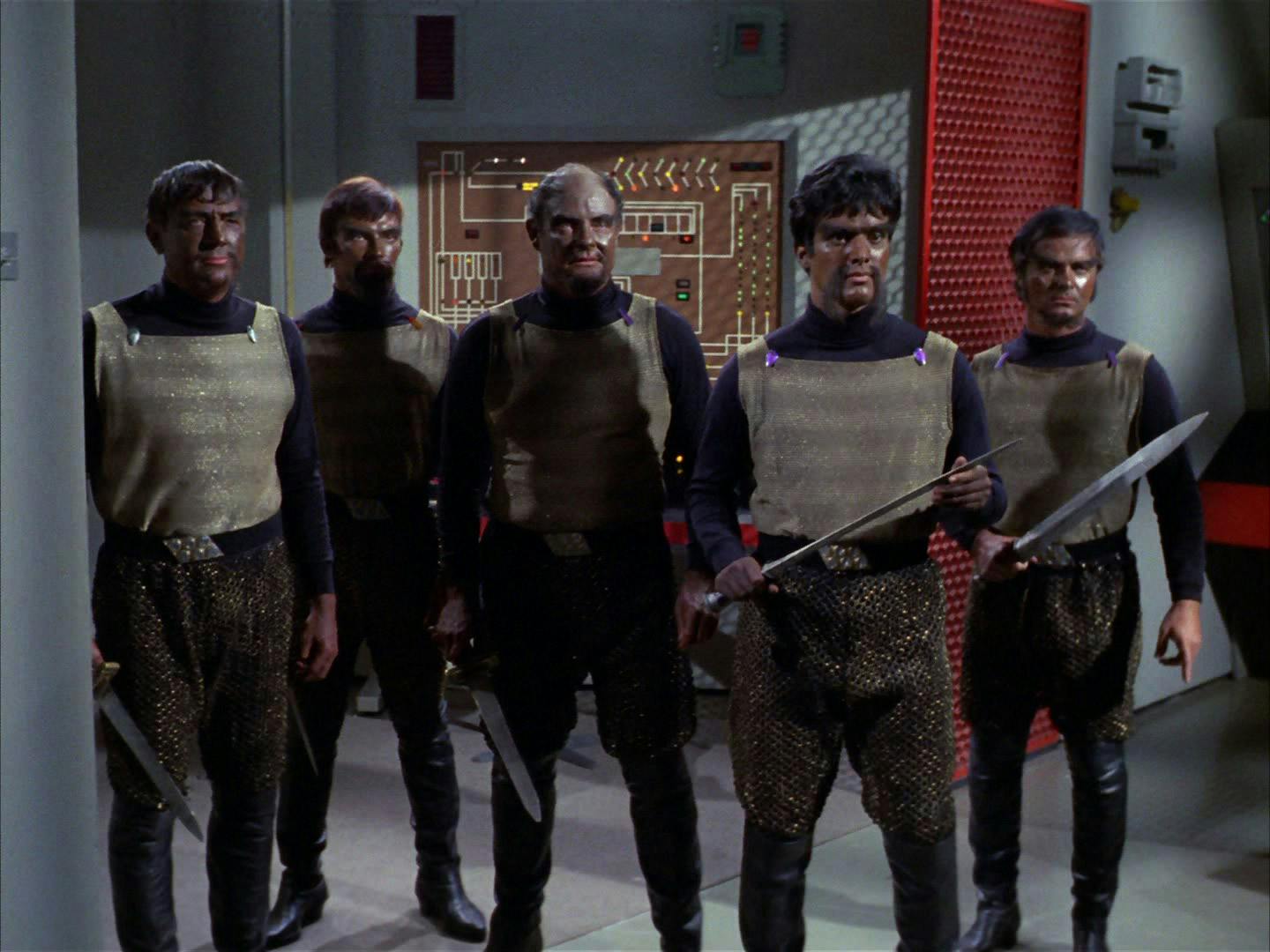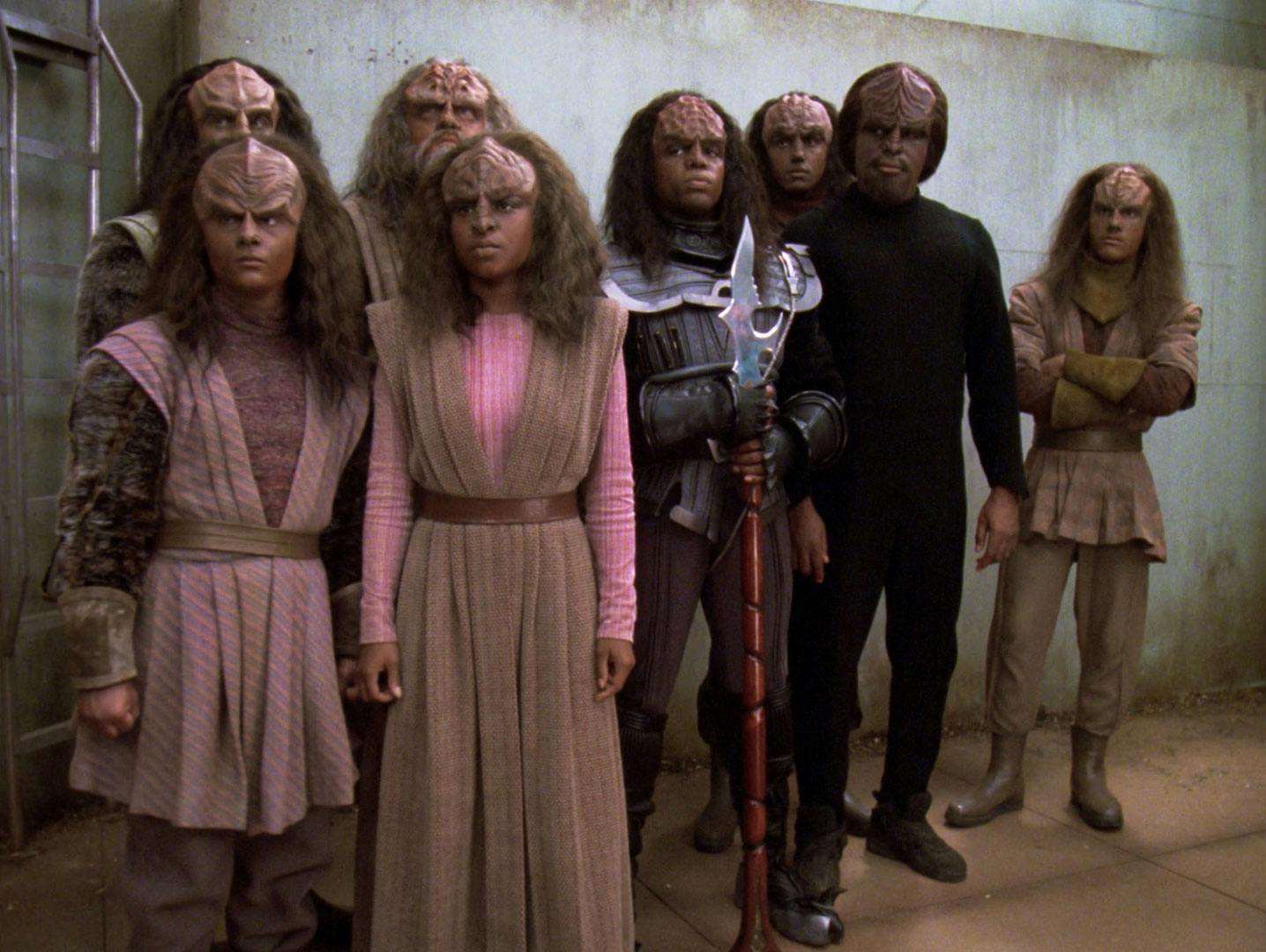Published Jul 3, 2024
The Klingon Language Is Star Trek's Secret Empathetic Weapon
In celebration of Marc Okrand's birthday, we're looking at how linguistics play a huge part in bringing our fandom community together.

StarTrek.com
Premiering in 1966, Star Trek is universally beloved and often regarded as the most famous science fiction television series and franchise of all time. And while some might point to the far-flung adventures, bold-but-beloved captains, or wacky holodeck romps when trying to explain the show's universal entertainment value, I've always pointed towards one particular aspect of the show — the Klingons — or, to be more specific, the Klingon language.
By looking at their unique, often guttural language, we can better understand how it contributes to creating the committed viewership and devoted fandom we know and love today. Stay with me here; I promise it'll all make sense in the end.

"Day of the Dove"
StarTrek.com
[RELATED: Qapla'! tugh tlhIngan Hol ghojchoHlaH Hoch!]
One of the most popular definitions of sci-fi comes from the Croatian science fiction critic Darko Suvin, who in 1979, identified a concept and phenomenon in the genre that he calls cognitive estrangement. Cognition is what Suvin calls an "imaginative framework" that can be understood by the audience — a world that makes logical sense and could be explained easily and believably. Estrangement stipulates that there has to be something different about the world that sets it apart from our world; something a little off or distancing, hence, "estrangement." So together, cognitive estrangement allows viewers an alternate world different enough from our own — that still makes sense logically and often scientifically, as it's not fantasy! — that allows them to perceive the sci-fi world and work in a new, untainted way.
In Star Trek, we too can see examples of both cognition and estrangement. It's easy to pick out examples of cognition, like the technological and scientific advancements such as the U.S.S. Enterprise — viewers understand space travel and the concept of teleportation, even if an advanced spaceship and a device like a transporter are both beyond our scientific grasp. Star Trek offers up estrangement simply in the show's setting of the future — the Federation as a central government is certainly something we can imagine, but it's clearly very different from our own world’s current political systems. Thus, when placed together, audiences are forced to put their own spin on the material because it's a world that's familiar, but not familiar enough to be able to interpret in the exact same way that we can interpret our own reality. Audiences can then develop new opinions, hopefully leave behind biases, and generate nuanced views of the fictional sci-fi world.

Marc Okrand flips through 'The Klingon Dictionary' as he's lifted up by two Klingons
Robert Sherbow
So where does Klingon come into play? Paramount Pictures commissioned American linguist Marc Okrand to create Klingon for Star Trek, which makes Klingon a constructed language (a language specifically created by someone for a purpose). Klingon itself has been heavily studied by both academics and fans alike, and in her 2009 book, In the Land of Invented Languages, American linguist Arika Okrent described Klingon as having certain traits that fulfill both cognition and estrangement. She stated that Klingon has "the feel of a natural language," while at the same time, it "gets its alien quality from the aspects that set it apart from natural languages." Sound familiar?
Klingon seems like it could logically fit in our own world, but it has something alien and something off about it, which makes it fit cognitive estrangement rather perfectly. In the same book, Okrent also said that Klingon "[makes] a certain kind of linguistic sense," but by an academic definition, "the phonological system of the language is, by design, harsh, guttural, and alien." It seems like it fits into our world, but upon closer examination, there's something estranging about it. Placed together, we find that cognitive estrangement is very clearly at play in many aspects of Klingon.

"Birthright, Part II"
StarTrek.com
However, beyond cognitive estrangement, constructed languages like Klingon have other important roles in a sci-fi world like Star Trek — world-building. In Joseph Lo Bianco's 2004 article "Invented Languages and New Worlds," and in Lawrie Barnes and Chantelle van Heerden's 2008 article, "Virtual Languages in Science Fiction and Fantasy Literature," the linguists contended that constructed languages function in ways that are very similar to natural languages in that they support the worlds of the stories and also play an extremely important role in "[constructing] meaning and identity." Many linguists also see constructed languages as a tool to build not only the sci-fi worlds, but also their constituent parts, including life, communities, and civilizations. Because of the vital role of language in our own lives to communicate and more, a constructed language becomes an integral component of a science fictional society because it is required for the society to function.
When Okrand created Klingon, he wanted to make the language as believable as possible, which also helped to craft the Star Trek world. In his 2011 From Elvish to Klingon: Exploring Invented Languages, English historian Michael Adams discussed how Okrand decided that the "best way to make the language sound real was to make it real — to devise phonological and grammatical systems and to make use of a consistent vocabulary" — and Okrand went on to create one of the most popular constructed languages ever. Okrand added more and more vocabulary, and eventually, Klingon went above and beyond the language's intended usage for the imagined world of Star Trek and began to unintentionally influence the sci-fi world and societies in it beyond simply existing in it. Adams described how "the motive for inventing Klingon in the first place was more or less instrumental," while "inventing more Klingon became important to the Star Trek brand" as we know and love it today. Nevertheless, the expansion of Klingon into a full constructed language did so much more than just serving to make the show believable; it brought an "imagined civilization to life" and assisted in "[immersing] people in the invented worlds and cultures presented to them."
Mary Chieffo Teaches the Perfect Beginner Klingon Phrase
Klingon goes far beyond simply being spoken on the show — it's extremely popular as a language for learning. According to Okrent, in her book In the Land of Invented Languages, Klingon is second only to Esperanto in terms of the number of speakers, and Esperanto is a language that was devised for a function purpose in real life. She also describes the phenomenon of Star Trek as an obsession and love, and she suggests that Klingon is so popular because the challenge of learning it is actually the most engaging and interesting part about it. Klingon is a form of language and communication familiar to us, but the difficult-to-learn, alien quality of the constructed language is so fascinating that it brings in even more fans and learners. This quality of estrangement in Klingon allows viewers to connect empathetically with Star Trek, but the language rooted enough in our own cognitive understanding of language that we can both learn it like we can any other language and understand how it functions in the world of Star Trek.
Klingon is only one example of constructed languages in television, film, literature, and other works of sci-fi and more. However, it is one of the most well-known and has such a strong linguistic basis that the extent to which someone could speak in Klingon is nearly the same as English. Okrent estimates that there are perhaps at most a few dozen fluent Klingon speakers. Being one of the most complete examples of a constructed language, Klingon is on the extreme end of the spectrum, as many constructed languages in science fiction television are only developed enough for the sake of being seen on television or in other mediums (think Kryptonian — sorry, Superman and Supergirl).
But other fully constructed languages are also growing in popularity — think about how languages like Dothraki and Valyrian (both constructed languages built for the show by linguist David J. Peterson) contribute to the life-like, extraordinary fleshed-out world of Game of Thrones. Yet the depth and breadth of Klingon’s vocabulary, popularity, and ability for usage places Klingon in the unique position of being both linguistically and artistically supported by academic communities and the public, which makes it hugely popular around the world. The communities that are passionate about Star Trek and Klingon are enormous — linguistics and popular culture nerd finally have something to talk about together at a con!

"Prophecy"
StarTrek.com
Other constructed languages may not have as strong of an empathetic effect on people as Klingon does because of how similar it is to a natural language as well as its qualities of cognitive estrangement. Nevertheless, Klingon's strong linguistic background together with its otherworldly, alien nature is enticing to so many speakers, making it an interesting, wonderful, and simply delightful language to learn and also just learn about.
As such, Klingon is an example of how constructed languages can serve to strongly connect viewers with a work of science fiction television and provide a source of empathy. Perhaps the ability to bond with linguistics at a Star Trek convention are more common than you might think; Okrent herself went to a Klingon language con for research and discovered that Klingon "suited the personal taste of a certain group of people so well that as soon as they saw it, they fell in love, clamored for more, and formed a community that brought it to life."
Klingon may contribute to the innately complex world-building of Star Trek, but it also connects audiences much more deeply to the story and characters as well. While constructed languages do contribute to the crucial job of world-building in sci-fi television, they also serve as an extremely important way for audiences to build empathetic connections with the material through cognitive estrangement (and thank you, Darko Suvin — awesome name as well, by the way). So sci-fi creators out there, take note — maybe you’ll want to build a constructed language of your own.

